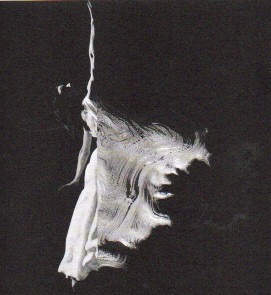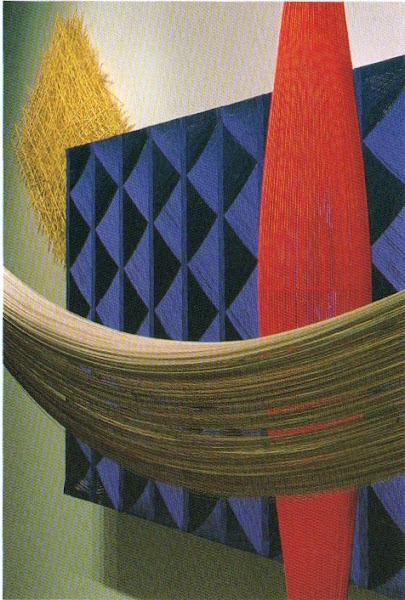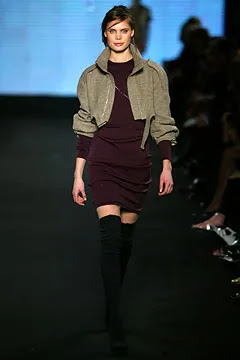Preamble [1]
'Melbourne Now' was an art exhibition mounted by the National Gallery of Victoria (Melbourne, Australia) in 2014. It takes as its premise the idea that a city is significantly shaped by the artists, designers, architects, choreographers, intellectuals and community groups that live and work in its midsts. The aim is to explore how Melbourne's visual artists and creative practitioners contribute to the dynamic cultural identity of this city. The result is an exhibition that celebrates what is unique about Melbourne's art, design, and architecture communities.
The intention of this exhibition is to encourage and inspire everyone to discover some of the best of Melbourne's culture. To help achieve this, family-friendly activities, dance and music performances, inspiring talks from creative practitioner's, city walks and ephemeral installations and events made up the public program.
This and other posts in this series will concentrate on the participating artists rather than on other features of the exhibition event (e.g., family-friendly commisions developed especially for children and young audiences that aimed to encourage participatory learning for kids and families etc.)
For your convenience I have listed below other posts on thie blogspot that features Melbourne Now exhibitions:
Melbourne Now - Part I
Melbourne Now - Part II
Melbourne Now - Part III
Melbourne Now - Part IV
Melbourne Now - Part IV[1]
Boris Cipusev
Boris Cipusev was born in 1988 and has been working at Arts Project Australia, Melbourne, since 2007. A prolific and dedicated practitioner, Cipusev has participated in numerous group exhibitions in Melbourne and Sydney since 2007. The artist's beautifully concise and considered drawings present text as images. Often employing two words or a word and number in combination. Cipusev's works yield both enigmatic juxapositions and poetic resonances. For the artist these words - sometimes names of people he knows or figures from popular culture - have specific meaning. Cipusev also draws inspiration from advertising and signage observed on his way to and from the studio, and from everyday printed material. His works are often conceived in a series of four parts, that are completed in a single session.
Cipusev's works included in 'Melbourne Now' display the striking and sophisticated use of contrast between figure and ground characteristic of his practice, with letters and words carefully placed and spaced against a plain white background. Drawn with a felt-tipped pen, the works are highly colored and precisely delineated, and their clarity and directness produced an effect both playful and emphatic.
Who Next? (2010)
Community Hall
Melbourne (Australia) is renowned as being complex, multicultural and multilayered - qualities that the city embraces through its arts, design, fashion, food, sport, and cultural events. As a purpose-built space dedicated to Melbourne's diverse communities, 'Community Hall' strives to reach beyond the walls of the National Gallery of Victoria to all corners of Melbourne, encouraging conversation and exchange with visitors young and old. For more than one hundred days, its circular design, reminiscent of an amphi-theatre, will accommodate a wide range of community groups, artist-run initiatives, art and design collectives, students, specialists, performers collectors, mentors, makers and hobbyists.
Community Hall's rich programming streams will draw out different facets of Melbourne's cultural fabric. Visitors will be treated to a variety of weekly public programs, including Masterclass, Talking Now, Show and Tell, The Menu, MN Project, Show-Off, DIY, Guess Who's Next, Melbourne Music and MN screenings, all celebrating the diversity of this dynamic city through a schedule of events co-created by you.
McBride Charles Ryan. Community Hall (2013).
Lorraine Connelly-Northey
Lorraine Connelly-Northey was born and grew up in Wadi Wadi and Wamba Wamba terrain south of her mother's Waradgerie Country, disconnected from mainsprings of her culture, language and ceremony as a consequence of colonization. Rather than practicing her people's customary art of coil weaving with sedge grasses, Connelly-Northey has forged a dramatic sculptural practice that suits her personal history and hybrid cultural identity. She re-fashions discarded post-industrial materials - the detritus of colonization - into objects and installations resonant with cultural meaning.
For 'Melbourne Now' Connelly-Northey has constructed two collosal installations, both of which heighten the gulf between pre-contact and post-contact colonial society. The first, 'An O'possum-skin cloak: Blackfella Road (2011-2013) refers to an unsealed road near Swan Hill (Victoria, Australia) made from soil taken from culturally sensitive areas containing middens and Aboriginal human remains. This road is boycotted by Connelly-Northey and her family and continues to haunt the artist, as does her memory of visiting, and witnessing, such decimated sites with her father. Connelly-Northey's second installation, 'Vessels' (2013), a commanding assemblage of giant rusted narbongs (collecting bags) made from incongruous materials, celebrates and memorializes such cultural objects.
Lorraine Connelly-Northey. An O'possum-skin cloak: Blackfella Road (2011).
Alan Constantable
Alan Constable is a Melbourne-based (Australia) artist who has been actively practising since 1985. Working principally from Northcote studios of Arts Project Australia, he has had wider ranging critical success in a diversity of media, including pastel on paper, ink on paper, oil on canvass, and more recently, ceramics, and is represented in many national and international collections. Of Constable's diverse works, it is his unique ceramic cameras that stand out as the most significant aspect of his recent practice.
A camera's ability to act as an extension of our eyes and to capture and preserve images renders it a potent instrument. In the case of Constable, this power has particular resonance and added poignancy. The artist lives with profound vision impairment and his compelling hand-modeled ceramic reinterpretations of the camera - itself sometimes referred to as the 'inventive eye' - posssess an altogether more moving presence. For Melbourne Now, Constable has created a special group of his very personal cameras.
Untitled (2013). Teal SRL with flash.
Ross Coulter
Ross Coulter's practice encompasses photography, film-making, sculpture, painting and dance, and is as interesting as it is diverse. Coulter is prolific and his work has been exhibited extensively around Melbourne (Australia), from the smallest artist-run initiatives to the National Gallery of Victoria (Melbourne, Australia). He has received numerous awards, grants and residencies both locally and internationally.
With '10,000 Paper Planes - Aftermath' (2011), Coulter encountered Melbourne's intellectual heart, the State Library of Victoria (SLV). Being awarded the Georges Mora Foundation Fellowship in 2010, allowed Coulter to realize a concept he had been developing since he worked at the SLV in the late 1990s. The result is a playful intervention into what is usually a serious place of contemplation. Coulter's paper planes, launched by 165 volunteers into the volume of the La Trobe Reading Room, give physical form to the notion of ideas flying through the building and the mind. This astute work investigates the striking contrast between strict discipline of the library space and its categorization system and the free flow of creativity that its holdings inspire in the vistor.
Ross Coulter, 10,000 Paper Planes - Aftermath (2011) in the State Library of Victoria.
Zoë Groggon. Fonteyn (2012).
Born in 1989, Zoë Croggon completed a Bachelor of Fine Arts in 2011, where she received the prestigious ACACIA Art Award. She currently lives and works in Melbourne (Australia). Recent group and solo exhibitions in the city include: Pool (2013), Dodecahedron (2012) and Liquid Archive at Monash University Museum of Art (2012).
Combining interests in video, sculpture, architecture, dance and drawing, as well as the open-ended possibilities afforded by reclaiming archival images, Croggon revels in unexpected juxtapositions of forms and textures. Her recent practice has culminated in merging disparate images, found and gathered, into deft and delicate collages. Drawing in personal experiences of studying ballet and dance, Croggon's photo-collages see human forms forced into visual dialogue with images of architecture and natural sites sourced from magazines, newspapers and books. She invests the images with new currency through the creation of dynamic visual and graphic synergies that have a profound sense of movement, energy and poetry.
Fonteyn (2012). National Gallery of Victoria (Melbourne).
Reference
[1] T. Ellwood, Director, National Gallery of Victoria (Melbourne, Australia).
'Melbourne Now' was an art exhibition mounted by the National Gallery of Victoria (Melbourne, Australia) in 2014. It takes as its premise the idea that a city is significantly shaped by the artists, designers, architects, choreographers, intellectuals and community groups that live and work in its midsts. The aim is to explore how Melbourne's visual artists and creative practitioners contribute to the dynamic cultural identity of this city. The result is an exhibition that celebrates what is unique about Melbourne's art, design, and architecture communities.
The intention of this exhibition is to encourage and inspire everyone to discover some of the best of Melbourne's culture. To help achieve this, family-friendly activities, dance and music performances, inspiring talks from creative practitioner's, city walks and ephemeral installations and events made up the public program.
This and other posts in this series will concentrate on the participating artists rather than on other features of the exhibition event (e.g., family-friendly commisions developed especially for children and young audiences that aimed to encourage participatory learning for kids and families etc.)
For your convenience I have listed below other posts on thie blogspot that features Melbourne Now exhibitions:
Melbourne Now - Part I
Melbourne Now - Part II
Melbourne Now - Part III
Melbourne Now - Part IV
Melbourne Now - Part IV[1]
Boris Cipusev
Boris Cipusev was born in 1988 and has been working at Arts Project Australia, Melbourne, since 2007. A prolific and dedicated practitioner, Cipusev has participated in numerous group exhibitions in Melbourne and Sydney since 2007. The artist's beautifully concise and considered drawings present text as images. Often employing two words or a word and number in combination. Cipusev's works yield both enigmatic juxapositions and poetic resonances. For the artist these words - sometimes names of people he knows or figures from popular culture - have specific meaning. Cipusev also draws inspiration from advertising and signage observed on his way to and from the studio, and from everyday printed material. His works are often conceived in a series of four parts, that are completed in a single session.
Cipusev's works included in 'Melbourne Now' display the striking and sophisticated use of contrast between figure and ground characteristic of his practice, with letters and words carefully placed and spaced against a plain white background. Drawn with a felt-tipped pen, the works are highly colored and precisely delineated, and their clarity and directness produced an effect both playful and emphatic.
Who Next? (2010)
Community Hall
Melbourne (Australia) is renowned as being complex, multicultural and multilayered - qualities that the city embraces through its arts, design, fashion, food, sport, and cultural events. As a purpose-built space dedicated to Melbourne's diverse communities, 'Community Hall' strives to reach beyond the walls of the National Gallery of Victoria to all corners of Melbourne, encouraging conversation and exchange with visitors young and old. For more than one hundred days, its circular design, reminiscent of an amphi-theatre, will accommodate a wide range of community groups, artist-run initiatives, art and design collectives, students, specialists, performers collectors, mentors, makers and hobbyists.
Community Hall's rich programming streams will draw out different facets of Melbourne's cultural fabric. Visitors will be treated to a variety of weekly public programs, including Masterclass, Talking Now, Show and Tell, The Menu, MN Project, Show-Off, DIY, Guess Who's Next, Melbourne Music and MN screenings, all celebrating the diversity of this dynamic city through a schedule of events co-created by you.
McBride Charles Ryan. Community Hall (2013).
Lorraine Connelly-Northey
Lorraine Connelly-Northey was born and grew up in Wadi Wadi and Wamba Wamba terrain south of her mother's Waradgerie Country, disconnected from mainsprings of her culture, language and ceremony as a consequence of colonization. Rather than practicing her people's customary art of coil weaving with sedge grasses, Connelly-Northey has forged a dramatic sculptural practice that suits her personal history and hybrid cultural identity. She re-fashions discarded post-industrial materials - the detritus of colonization - into objects and installations resonant with cultural meaning.
For 'Melbourne Now' Connelly-Northey has constructed two collosal installations, both of which heighten the gulf between pre-contact and post-contact colonial society. The first, 'An O'possum-skin cloak: Blackfella Road (2011-2013) refers to an unsealed road near Swan Hill (Victoria, Australia) made from soil taken from culturally sensitive areas containing middens and Aboriginal human remains. This road is boycotted by Connelly-Northey and her family and continues to haunt the artist, as does her memory of visiting, and witnessing, such decimated sites with her father. Connelly-Northey's second installation, 'Vessels' (2013), a commanding assemblage of giant rusted narbongs (collecting bags) made from incongruous materials, celebrates and memorializes such cultural objects.
Lorraine Connelly-Northey. An O'possum-skin cloak: Blackfella Road (2011).
Alan Constantable
Alan Constable is a Melbourne-based (Australia) artist who has been actively practising since 1985. Working principally from Northcote studios of Arts Project Australia, he has had wider ranging critical success in a diversity of media, including pastel on paper, ink on paper, oil on canvass, and more recently, ceramics, and is represented in many national and international collections. Of Constable's diverse works, it is his unique ceramic cameras that stand out as the most significant aspect of his recent practice.
A camera's ability to act as an extension of our eyes and to capture and preserve images renders it a potent instrument. In the case of Constable, this power has particular resonance and added poignancy. The artist lives with profound vision impairment and his compelling hand-modeled ceramic reinterpretations of the camera - itself sometimes referred to as the 'inventive eye' - posssess an altogether more moving presence. For Melbourne Now, Constable has created a special group of his very personal cameras.
Untitled (2013). Teal SRL with flash.
Ross Coulter
Ross Coulter's practice encompasses photography, film-making, sculpture, painting and dance, and is as interesting as it is diverse. Coulter is prolific and his work has been exhibited extensively around Melbourne (Australia), from the smallest artist-run initiatives to the National Gallery of Victoria (Melbourne, Australia). He has received numerous awards, grants and residencies both locally and internationally.
With '10,000 Paper Planes - Aftermath' (2011), Coulter encountered Melbourne's intellectual heart, the State Library of Victoria (SLV). Being awarded the Georges Mora Foundation Fellowship in 2010, allowed Coulter to realize a concept he had been developing since he worked at the SLV in the late 1990s. The result is a playful intervention into what is usually a serious place of contemplation. Coulter's paper planes, launched by 165 volunteers into the volume of the La Trobe Reading Room, give physical form to the notion of ideas flying through the building and the mind. This astute work investigates the striking contrast between strict discipline of the library space and its categorization system and the free flow of creativity that its holdings inspire in the vistor.
Ross Coulter, 10,000 Paper Planes - Aftermath (2011) in the State Library of Victoria.
Zoë Groggon. Fonteyn (2012).
Born in 1989, Zoë Croggon completed a Bachelor of Fine Arts in 2011, where she received the prestigious ACACIA Art Award. She currently lives and works in Melbourne (Australia). Recent group and solo exhibitions in the city include: Pool (2013), Dodecahedron (2012) and Liquid Archive at Monash University Museum of Art (2012).
Combining interests in video, sculpture, architecture, dance and drawing, as well as the open-ended possibilities afforded by reclaiming archival images, Croggon revels in unexpected juxtapositions of forms and textures. Her recent practice has culminated in merging disparate images, found and gathered, into deft and delicate collages. Drawing in personal experiences of studying ballet and dance, Croggon's photo-collages see human forms forced into visual dialogue with images of architecture and natural sites sourced from magazines, newspapers and books. She invests the images with new currency through the creation of dynamic visual and graphic synergies that have a profound sense of movement, energy and poetry.
Fonteyn (2012). National Gallery of Victoria (Melbourne).
Reference
[1] T. Ellwood, Director, National Gallery of Victoria (Melbourne, Australia).


























































